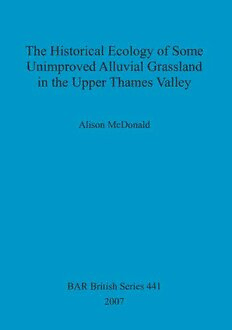
The Historical Ecology of some Unimproved Alluvial Grassland in the Upper Thames Valley PDF
178 Pages·2007·65.922 MB·English
Most books are stored in the elastic cloud where traffic is expensive. For this reason, we have a limit on daily download.
Preview The Historical Ecology of some Unimproved Alluvial Grassland in the Upper Thames Valley
Description:
This volume, on a delightful area within sight of the towers and spires of central Oxford, is the result of 25 years work by the author. It began as a desk study which generated sufficient interest for the author to work on a base-line botanical survey of Port Meadow with Wolvercote Common, ancient pasture, and to contrast it with a similar survey of Picksey Mead, ancient hay-meadow. The historical research was extended to look at the history of the management of both these flood-plain areas in order to understand something of the differences in their species-composition and to enable the author to relate them to their past management. The pioneering environmental archaeology undertaken in the area is now an authoritative discipline and the ground-breaking use of a multi-disciplinary approach to grassland studies is at last being recognised by Natural England and others as an essential element in management plans for Sites of Special Scientific Interest. Since the early 1980s grants have been available for increasingly in-depth studies of a single topic. The publication of this volume represents a change of view in which multi-disciplinary studies, especially those relating to the history of man and the landscape he has influenced are recognized for the breadth of vision which is their strength. The description of the vegetation has proved invaluable when working with English Nature (now Natural England) over the intervening years as it provided a base-line from which natural and man-made changes in the vegetation could be measured. In particular, the description of Port Meadow Marsh was vital in connection with the study of Apium repens carried out by the Rare Plants Group of the Ashmolean Natural History Society of Oxfordshire for English Nature from 1996–2006. The author has brought the descriptions of the various communities into line with the relevant volumes of John Rodwell's British Plant Communities. The historical sections of the work have also stood the test of time and have been brought up to date where necessary and incorporated into this new volume. With the current interest in flood-alleviation plans for West Oxford, which include the possibility of constructing new channels associated with overflow areas within the river Thames flood-plain above Oxford, which could affect the hydrology and therefore the vegetation of these ancient pastures and meads, publication of this work is timely.
See more
The list of books you might like
Most books are stored in the elastic cloud where traffic is expensive. For this reason, we have a limit on daily download.
